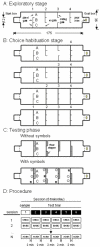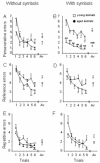The three-panel runway maze adapted to Microcebus murinus reveals age-related differences in memory and perseverance performances
- PMID: 20403446
- PMCID: PMC2881169
- DOI: 10.1016/j.nlm.2010.04.006
The three-panel runway maze adapted to Microcebus murinus reveals age-related differences in memory and perseverance performances
Abstract
Microcebus murinus, a mouse lemur primate appears to be a valuable model for cerebral aging study and for Alzheimer's disease model since they can develop beta-amyloid plaques with age. Although the biological and biochemical analyses of cerebral aging are well documented, the cognitive abilities of this primate have not been thoroughly characterized. In this study, we adapted a spatial working memory procedure described in rodents, the sequential choice task in the three-panel runway, to mouse lemurs. We analyzed the age-related differences in a procedural memory task in the absence or presence of visual cues. Sixty percent of young adult and 48% of aged lemurs completed the exploratory, choice habituation and testing phases at the beginning of the procedure. Young adult lemurs showed a higher level of perseverative errors compared with aged animals, particularly in the presence of visual stimuli. Over trials, old animals made more reference errors compared to young ones that improved quickly their performances under random level. No significant improvement was observed in young adults and old ones over sessions. This study showed that behavioural performances of M. murinus assessed on the sequential choice task in the three-panel runway markedly differ from the previously reported abilities of rodents. The behavioural response of young adult lemurs was influenced by novelty-related anxiety that contributed to their performance in terms of perseverative errors. Conversely, aged lemurs showed less perseverative errors, a rapid habituation to the three-panel runway maze, but made more memory errors. Overall, these findings demonstrate the feasibility to use the three-panel runway task in assessing memory performance, particularly in aged mouse lemurs.
Figures




Similar articles
-
Aging affects executive functions and memory in mouse lemur primates.Exp Gerontol. 2007 Mar;42(3):223-32. doi: 10.1016/j.exger.2006.09.013. Epub 2006 Nov 3. Exp Gerontol. 2007. PMID: 17084573
-
Spatial memory in the grey mouse lemur (Microcebus murinus).Anim Cogn. 2009 Jul;12(4):599-609. doi: 10.1007/s10071-009-0219-y. Epub 2009 Mar 5. Anim Cogn. 2009. PMID: 19263100 Free PMC article.
-
Effects of aging upon recent memory in Microcebus murinus.Aging (Milano). 1995 Feb;7(1):17-22. doi: 10.1007/BF03324285. Aging (Milano). 1995. PMID: 7599242
-
Microcebus murinus: a useful primate model for human cerebral aging and Alzheimer's disease?Genes Brain Behav. 2006 Mar;5(2):120-30. doi: 10.1111/j.1601-183X.2005.00149.x. Genes Brain Behav. 2006. PMID: 16507003 Review.
-
The gray mouse lemur (Microcebus murinus) as a model for early primate brain evolution.Curr Opin Neurobiol. 2021 Dec;71:92-99. doi: 10.1016/j.conb.2021.09.012. Epub 2021 Nov 9. Curr Opin Neurobiol. 2021. PMID: 34768148 Review.
Cited by
-
Amyloid-β targeting immunisation in aged non-human primate (Microcebus murinus).Brain Behav Immun. 2023 Mar;109:63-77. doi: 10.1016/j.bbi.2022.12.021. Epub 2022 Dec 30. Brain Behav Immun. 2023. PMID: 36592872 Free PMC article.
-
Hearing and age-related changes in the gray mouse lemur.J Assoc Res Otolaryngol. 2014 Dec;15(6):993-1005. doi: 10.1007/s10162-014-0478-4. Epub 2014 Aug 12. J Assoc Res Otolaryngol. 2014. PMID: 25112886 Free PMC article.
-
Contributions of Nonhuman Primates to Research on Aging.Vet Pathol. 2016 Mar;53(2):277-90. doi: 10.1177/0300985815622974. Epub 2016 Feb 11. Vet Pathol. 2016. PMID: 26869153 Free PMC article. Review.
-
Photoperiodic regime influences onset of lens opacities in a non-human primate.PeerJ. 2017 May 4;5:e3258. doi: 10.7717/peerj.3258. eCollection 2017. PeerJ. 2017. PMID: 28484672 Free PMC article.
-
CAV-2 Vector Development and Gene Transfer in the Central and Peripheral Nervous Systems.Front Mol Neurosci. 2019 Mar 29;12:71. doi: 10.3389/fnmol.2019.00071. eCollection 2019. Front Mol Neurosci. 2019. PMID: 30983967 Free PMC article. Review.
References
-
- Aujard F, Dkhissi-Benyahya O, Fournier I, Claustrat B, Schilling A, Cooper HM, Perret M. Artificially accelerated aging by shortened photoperiod alters early gene expression (Fos) in the suprachiasmatic nucleus and sulfatoxymelatonin excretion in a small primate. Microcebus murinus. Neuroscience. 2001;105(2):403–412. - PubMed
-
- Beaudreau SA, O’Hara R. Late-life anxiety and cognitive decline: A review. American Journal of Geriatric Psychiatry. 2008;16:790–803. - PubMed
-
- Bons N, Jallageas V, Silhol S, Mestre-Frances N, Petter A, Delacourte A. Immunocytochemical characterization of Tau proteins during cerebral aging of the lemurian primate Microcebus murinus. Comptes Rendus de l’Académie des Sciences III. 1995;318(1):77–83. - PubMed
-
- Bons N, Silhol S, Barbie V, Mestre-Frances N, Albe-Fessard D. A stereotaxic atlas of the grey lesser mouse lemur brain (Microcebus murinus) Brain Research Bull. 1998;46(1- 2):1–173. - PubMed
-
- Bons N, Rieger F, Prudhomme D, Fisher A, Krause KH. Microcebus murinus: a useful primate model for human cerebral aging and Alzheimer’s disease? Genes Brain Behavior. 2006;5(2):120–30. - PubMed
Publication types
MeSH terms
Grants and funding
LinkOut - more resources
Full Text Sources
Medical

